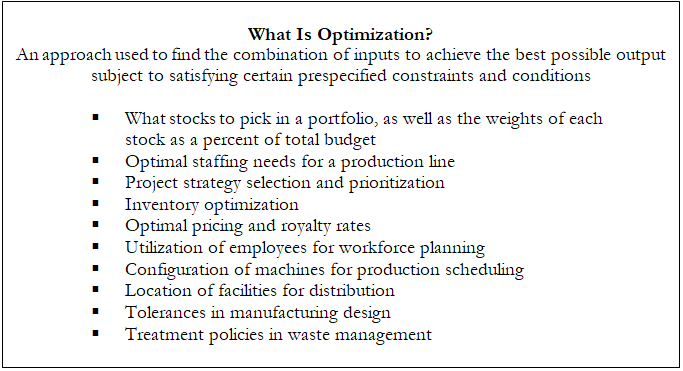In today’s competitive global economy, companies are faced with many difficult decisions. These decisions include allocating financial resources, building or expanding facilities, managing inventories, and determining product-mix strategies (Figure 16.1). Such decisions might involve thousands or millions of potential alternatives. Considering and evaluating each of them would be impractical or even impossible. A model can provide valuable assistance in incorporating relevant variables when analyzing decisions and finding the best solutions for making decisions. Models capture the most important features of a problem and present them in a form that is easy to interpret. Models often provide insights that intuition alone cannot. An optimization model has three major elements: decision variables, constraints, and an objective. In short, the optimization methodology finds the best combination or permutation of decision variables (e.g., which products to sell and which projects to execute) in every conceivable way such that the objective is maximized (e.g., revenues and net income) or minimized (e.g., risk and costs) while still satisfying the constraints (e.g., budget and resources).
Obtaining optimal values generally requires that you search in an iterative or ad hoc fashion. This search involves running one iteration for an initial set of values, analyzing the results, changing one or more values, rerunning the model, and repeating the process until you find a satisfactory solution. This process can be very tedious and time-consuming even for small models, and often it is not clear how to adjust the values from one iteration to the next.
A more rigorous method systematically enumerates all possible alternatives. This approach guarantees optimal solutions if the model is correctly specified. Suppose that an optimization model depends on only two decision variables. If each variable has 10 possible values, trying each combination requires 100 iterations (102 alternatives). If each iteration is very short (e.g., 2 seconds), then the entire process could be done in approximately three minutes of computer time.
However, instead of two decision variables, consider six, then consider that trying all combinations requires 1,000,000 iterations (106 alternatives). It is easily possible for complete enumeration to take weeks, months, or even years to carry out.

Figure 16.1: What Is Optimization?

